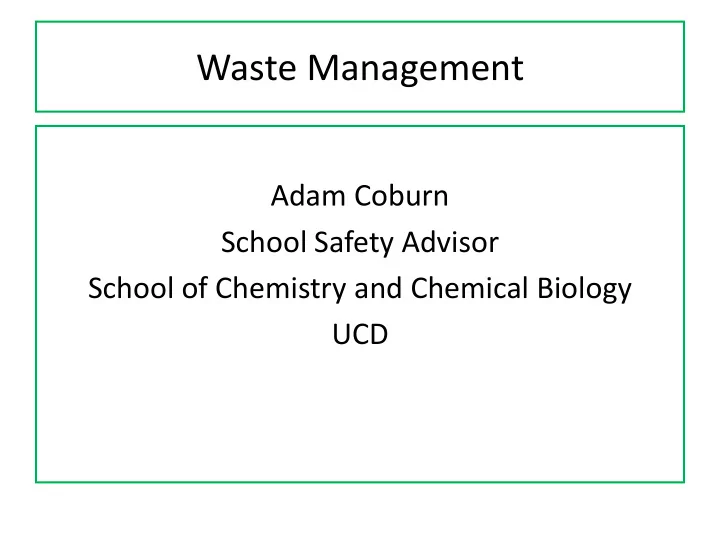

Waste Management Adam Coburn School Safety Advisor School of Chemistry and Chemical Biology UCD
Waste • Who’s responsibility is waste?
School waste procedures • School hazardous waste management plan – School policy - enforced in all labs – Clear SOPs for each waste type • Minimizes cost – Prevents the over classification of waste • Ensures legal compliance – H&S, environmental protection and transport
Trying to prevent
Trying to prevent
Trying to prevent
Trying to prevent
SCCB hazardous waste streams flowchart Non-halogenated Solvents/ Halogenated solutions Aqueous (non regulated and approved) Non-contaminated General Chemically contaminated waste Biologically & chemically contaminated Biologically contaminated Soft waste Chemically contaminated Sharps/ glass Biologically contaminated Alumina/Silica Rigid waste Winchester bottles Recognizable animal tissue (labels removed and triple rinsed) Brown glass Plastic/aluminium/clear glass Irregular waste Contact ???? GMM/GMO
Waste compound
School of Chemistry and Chemical Biology Celtic catalysts Food Chem Food Science Eng Safety Emergency Emergency shower exit
Waste compound
Barcode tracking • All waste containers are barcoded for tracking purposes • Containers scanned into the system • Acts as a deterrent to misuse of the system
Labelling waste containers • Recommend labels to identify School of origin - Should prevent errors in payment - In the event of an accident/incident.....
SCCB hazardous waste streams flowchart Non-halogenated Solvents/ Halogenated solutions Aqueous (non regulated and approved)
Procedure for using 10L waste containers • Order container on eProcurement • Collect from Stores • Use to collect waste – Store and use sensibly in your lab space • Only fill to 90% - leave 10% ullage space • Bring to Stores using lock out lift – Place in the appropriate area
Note on Aqueous waste • Aqueous waste must be neutralised Not acceptable!
Solvents/solutions € 18.80/10L What happens to this waste? Shipped to Belgium € 21.30/10L Incinerated @ ~1600°C € 19.60/10L
SCCB hazardous waste streams flowchart Non-halogenated Solvents/ Halogenated solutions Aqueous (non regulated and approved) Non-contaminated General Chemically contaminated waste Biologically & chemically contaminated Biologically contaminated Soft waste Rigid waste
Non-contaminated waste • Anything not chemically or biologically contaminated – Wrappings – Paper – No disposable gloves • Collected by cleaners or... • Cardboard boxes, etc.
Chemically contaminated waste • Red bags on stands • General lab waste only – No free liquids – No bottles of chemicals – No sharps!
Procedure for disposing of chemical waste • Order container on eProcurement • Collect from Stores • Use to collect waste – Store and use sensibly in your lab space • Only fill to 2/3 • Close and seal the bag • Bring to Stores using lock out lift – Place in the appropriate area
Notes on chemical waste • No Sharps! – Or anything which can pierce the bag • Recommend using a small tub for pipette tips etc Lid on → red bags
Notes on chemical waste • Try not to be wasteful – High cost and carbon footprint
Chemical waste in stores compound What happens to this waste? Shipped to Belgium Incinerated @ ~1600°C € 102.42/drum
Biologically contaminated waste • Yellow bags on stands • General lab waste only – No free liquids – No chemicals – No sharps! – Nothing that could pierce the bag • Legally “potentially infectious” • SOP same as chemically contaminated
Biological waste in stores compound • UN approved container for the transport of potentially infectious waste – Cannot be torn or ripped • Autoclaved in Kildare @ € 1.25/kg – Then put into landfill
Rigid biologically contaminated waste • 30L and 60L tubs • Use responsibly • Close and seal Autoclaved in Kildare • Bring to Stores @ € 1.25/kg
Chemically and biologically contaminated waste • For waste which is unavoidably both chemically and biologically contaminated What happens • Use responsibly to this waste? • Close and seal Shipped to Belgium • Bring to Stores Incinerated @ ~1600°C € 2.50/kg
SCCB hazardous waste streams flowchart Non-halogenated Solvents/ Halogenated solutions Aqueous (non regulated and approved) Non-contaminated General Chemically contaminated waste Biologically & chemically contaminated Biologically contaminated Soft waste Chemically contaminated Sharps/ glass Biologically contaminated Rigid waste
Chemically contaminated glass/sharps • Fill • Use responsibly – No free liquids • Close and seal • Bring to Stores – Using lock out lift € 85.36/each Incinerated in Belgium
Biologically and/or chemically contaminated sharps What happens • Fill to this waste? • Use responsibly Shipped to Belgium – No free liquids • Close and seal Incinerated @ ~1600°C • Bring to Stores € 2.50/kg – Using lock out lift
SCCB hazardous waste streams flowchart Non-halogenated Solvents/ Halogenated solutions Aqueous (non regulated and approved) Non-contaminated General Chemically contaminated waste Biologically & chemically contaminated Biologically contaminated Soft waste Chemically contaminated Sharps/ glass Biologically contaminated Alumina/Silica Rigid waste Winchester bottles Recognizable animal tissue (labels removed and triple rinsed) Glass Plastic/aluminium Irregular waste Contact ?????? GMM/GMO
Waste alumina/silica • Reuse an alumina/silica container • Label as “waste alumina” or “waste silica” and your name and group • Close and seal • Bring to stores
Recognisable animal tissue • Not only considered potentially infectious • Not generally produced • Into green bag, labelled → freezer
Genetically Modified Material • Require license to work with material • Contact Safety Office
Empty winchesters and bottles, etc • Emptied, triple rinsed and labels removed as per UCD policy Brown glass All recycled Plastic, Aluminium, clear glass, plastic tubs, etc
Irregular waste • Anything which does to fit into a waste stream is considered an “irregular laboratory small”
Irregular waste steps • Label the waste! (making sure it won’t come off) • Short description • Your name • Your research group • Hazard symbols/pictograms! • Contact SRCL?
SCCB hazardous waste streams flowchart Non-halogenated Solvents/ Halogenated solutions Aqueous (non regulated and approved) Non-contaminated General Chemically contaminated waste Biologically & chemically contaminated Biologically contaminated Soft waste Chemically contaminated Sharps/ glass Biologically contaminated Alumina/Silica Rigid waste Winchester bottles Recognizable animal tissue (labels removed and triple rinsed) Brown glass Plastic/aluminium/clear glass Irregular waste Contact ???? GMM/GMO
Recommend
More recommend